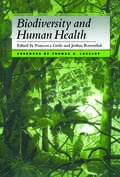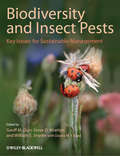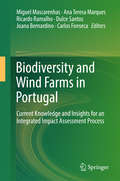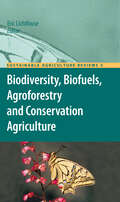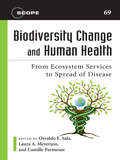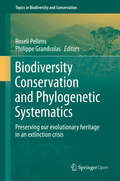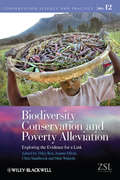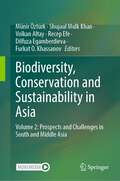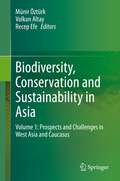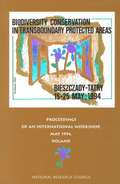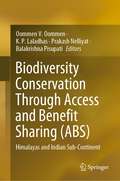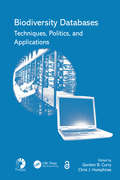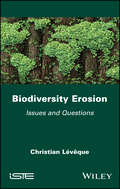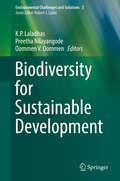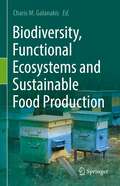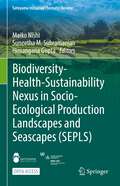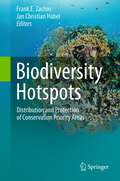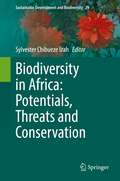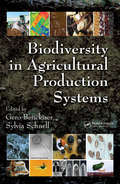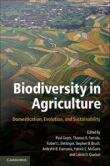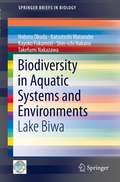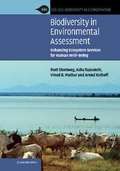- Table View
- List View
Biodiversity and Human Health
by Bhaswati Bhattacharya Mary Campbell Jensa Bell Michael Boyd Eric Chivian Paul CoxThe book provides a common framework for physicians and biomedical researchers who wish to learn more about environmental concerns, and for members of the environmental community who desire a greater understanding of biomedical issues.
Biodiversity and Insect Pests: Key Issues for Sustainable Management
by Geoff M. Gurr Stephen D. Wratten William E. SnyderBiodiversity offers great potential for managing insect pests. It provides resistance genes and anti-insect compounds; a huge range of predatory and parasitic natural enemies of pests; and community ecology-level effects operating at the local and landscape scales to check pest build-up. This book brings together world leaders in theoretical, methodological and applied aspects to provide a comprehensive treatment of this fast-moving field. Chapter authors from Europe, Asia, Africa, Australasia and the Americas ensure a truly international scope. Topics range from scientific principles, innovative research methods, ecological economics and effective communication to farmers, as well as case studies of successful use of biodiversity-based pest management some of which extend over millions of hectares or are enshrined as government policy. Written to be accessible to advanced undergraduates whilst also stimulating the seasoned researcher, this work will help unlock the power of biodiversity to deliver sustainable insect pest management. Visit www.wiley.com/go/gurr/biodiversity to access the artwork from the book.
Biodiversity and Wind Farms in Portugal: Current knowledge and insights for an integrated impact assessment process
by Miguel Mascarenhas Ana Teresa Marques Ricardo Ramalho Dulce Santos Joana Bernardino Carlos FonsecaThis book presents a review of the state-of-the-art knowledge on the interactions between biodiversity and wind energy development, focused on the Portuguese reality. The volume addresses the particularities of the impact assessment procedures in Portugal, contrasting it with the international practices and presenting its main findings by covering the following broader themes: i) evaluation of spatial and temporal dynamics of wildlife affected by wind farms, including birds, bats and terrestrial mammals (in particularly Portuguese wolf population); ii) the methodologies used to assess impacts caused by this type of developments in biodiversity; iii) the best practice methodologies to implement an adaptive management approach to reconcile biodiversity and wind farms. The knowledge presented in this book was gathered through the research and development activities developed by Bioinsight company (former Bio3 company) during the last 13 years and partially funded by a R&D project designated as "Integrated solutions for biodiversity management at wind farms: reduce and compensate bird and bat mortality" (acronym: Wind & Biodiversity), co-funded by the European Regional Development Fund (FEDER), under the Regional Operational Programme of Centre (Mais Centro). This volume fills a void in the literature as a book giving insights on the best practices to install and manage a wind farm from a biodiversity management point of view, while establishing a commitment between economic sustainability and biodiversity conservation.
Biodiversity, Biofuels, Agroforestry and Conservation Agriculture (Sustainable Agriculture Reviews #5)
by Eric LichtfouseSustainable agriculture is a rapidly growing field aiming at producing food and energy in a sustainable way for our children. This discipline addresses current issues such as climate change, increasing food and fuel prices, starvation, obesity, water pollution, soil erosion, fertility loss, pest control and biodiversity depletion. Novel solutions are proposed based on integrated knowledge from agronomy, soil science, molecular biology, chemistry, toxicology, ecology, economy, philosophy and social sciences. As actual society issues are now intertwined, sustainable agriculture will bring solutions to build a safer world. This book series analyzes current agricultural issues, and proposes alternative solutions, consequently helping all scientists, decision-makers, professors, farmers and politicians wishing to build safe agriculture, energy and food systems for future generations.
Biodiversity Change and Human Health: From Ecosystem Services to Spread of Disease (SCOPE Series #69)
by Osvaldo E. Sala Camille Parmesan Laura A. MeyersonBiodiversity Change and Human Health brings together leading experts from the natural science and social science realms as well as the medical community to explore the explicit linkages between human-driven alterations of biodiversity and documented impacts of those changes on human health. The book utilizes multidisciplinary approaches to explore and address the complex interplay between natural biodiversity and human health and well-being. The five parts examine health trade-offs between competing uses of biodiversity (highlighting synergistic situations in which conservation of natural biodiversity actually promotes human health and well-being); relationships between biodiversity and quality of life that have developed over ecological and evolutionary time; the effects of changing biodiversity on provisioning of ecosystem services, and how they have affected human health; the role of biodiversity in the spread of infectious disease; native biodiversity as a resource for traditional and modern medicine Biodiversity Change and Human Health synthesizes our current understanding and identifies major gaps in knowledge as it places all aspects of biodiversity and health interactions within a common framework. Contributors explore potential points of crossover among disciplines (both in ways of thinking and of specific methodologies) that could ultimately expand opportunities for humans to both live sustainably and enjoy a desirable quality of life.
Biodiversity Conservation and Phylogenetic Systematics: Preserving our evolutionary heritage in an extinction crisis (Topics in Biodiversity and Conservation #14)
by Roseli Pellens Philippe GrandcolasThis book is about phylogenetic diversity as an approach to reduce biodiversity losses in this period of mass extinction. Chapters in the first section deal with questions such as the way we value phylogenetic diversity among other criteria for biodiversity conservation; the choice of measures; the loss of phylogenetic diversity with extinction; the importance of organisms that are deeply branched in the tree of life, and the role of relict species. The second section is composed by contributions exploring methodological aspects, such as how to deal with abundance, sampling effort, or conflicting trees in analysis of phylogenetic diversity. The last section is devoted to applications, showing how phylogenetic diversity can be integrated in systematic conservation planning, in EDGE and HEDGE evaluations. This wide coverage makes the book a reference for academics, policy makers and stakeholders dealing with biodiversity conservation.
Biodiversity Conservation and Poverty Alleviation: Exploring the Evidence for a Link (Conservation Science and Practice)
by Dilys Roe Joanna Elliott Chris Sandbrook Matt WalpoleBiodiversity conservation and poverty alleviation are both important societal goals demanding increasing international attention. While they may seem to be unrelated, the international policy frameworks that guide action to address them make an explicit assumption that conserving biodiversity will help to tackle global poverty. Part of the Conservation Science and Practice Series published with the Zoological Society of London, this book explores the validity of that assumption. The book addresses a number of critical questions: Which aspects of biodiversity are of value to the poor? Does the relationship between biodiversity and poverty differ according to particular ecological conditions? How do different conservation interventions vary in their poverty impacts? How do distributional and institutional issues affect the poverty impacts of interventions? How do broader issues such as climate change and the global economic system affect the biodiversity – poverty relationship at different scales? This volume will be of interest to policy-makers, practitioners and researchers concerned with understanding the potential - and limitations - of integrated approaches to biodiversity conservation and poverty alleviation.
Biodiversity, Conservation and Sustainability in Asia: Volume 2: Prospects and Challenges in South and Middle Asia
by Dilfuza Egamberdieva Münir Öztürk Recep Efe Volkan Altay Shujaul Mulk Khan Furkat O. KhassanovOf the world’s seven continents, Asia is the largest. Its physical landscapes, political units, and ethnic groups are both wide-ranging and many. Southwest, South and Middle Asia are highly populated regions which, as a whole, cover an extremely large area of varied geography. In total, this domain is unique in its plant diversity and large vegetation zones with different communities and biomes. It is rich in endemics, with specific and intraspecific diversity of fruit trees and medicinal plants, including a number of rare, high value, species. At the same time, much of the land in the region is too dry or too rugged, with many geographical extremes. Overgrazing, oil and mineral extraction, and poaching are the major threats in the area. This two-volume project focuses on the dynamic biodiversity of the region with in-depth analysis on phytosociology, plants, animals and agroecology. There are also chapters that explore new applications as well as approaches to overcome problems associated with climate change. Much of the research and analysis are presented here for the first time. We believe this work is a valuable resource for professionals and researchers working in the fields of plant diversity and vegetation, animal diversity and animal populations, and geo-diversity and sustainable land use, among others.The first volume guides our readers to West Asia and the Caucasus region, while volume two focuses on issues unique to South and Middle Asia.
Biodiversity, Conservation and Sustainability in Asia: Volume 1: Prospects and Challenges in West Asia and Caucasus
by Münir Öztürk Volkan Altay Recep EfeOf the world’s seven continents, Asia is the largest. Its physical landscapes, political units, and ethnic groups are both wide-ranging and many. Southwest, South and Middle Asia are highly populated regions which, as a whole, cover an extremely large area of varied geography. In total, this domain is unique in its plant diversity and large vegetation zones with different communities and biomes. It is rich in endemics, with specific and intraspecific diversity of fruit trees and medicinal plants, including a number of rare, high value, species. At the same time, much of the land in the region is too dry or too rugged, with many geographical extremes. Overgrazing, oil and mineral extraction, and poaching are the major threats in the area.This two-volume project focuses on the dynamic biodiversity of the region with in-depth analysis on phytosociology, plants, animals and agroecology. There are also chapters that explore new applications as well as approaches to overcome problems associated with climate change. Much of the research and analysis are presented here for the first time. We believe this work is a valuable resource for professionals and researchers working in the fields of plant diversity and vegetation, animal diversity and animal populations, and geo-diversity and sustainable land use, among others.The first volume guides our readers to West Asia and the Caucasus region, while volume two focuses on issues unique to South and Middle Asia.
Biodiversity Conservation In Transboundary Protected Areas: Proceedings of an International Workshop Bieszczady and Tatra National Parks, Poland May 15-25, 1994
by National Research Council Staff Alicja Breymeyer Reginald NobleRecognizing the increasing rate of species loss on a global scale and that neither pollution nor ecosystems respects political boundaries, cooperation on many different levels is required to conserve biodiversity. This volume uses four protected areas that Poland shares with its neighbors as case studies to explore opportunities to integrate science and management in transboundary protected areas in Central Europe for the conservation of biodiversity. Specific topics include biodiversity conservation theories and strategies, problems of wildlife management, and impacts of tourism and recreational use on protected areas.
Biodiversity Conservation Through Access and Benefit Sharing (ABS): Himalayas and Indian Sub-Continent
by K. P. Laladhas Oommen V. Oommen Prakash Nelliyat Balakrishna PisupatiThis book deals with the economic potentials of biodiversity and its capacity to support its own conservation aiming to provide livelihood for millions engaged in conservation, both now and for future generations. The book highlights the potentials of natural resources which are characterized as capital wealth (as defined in Convention on Biological Diversity (CBD)), to finance its own conservation and to provide livelihood means to people who conserve it.The book is divided into five Parts. PART I explains about the Premise of Access and Benefit Sharing (ABS), PART II describes about the Technology Transfer, PART III will provide details about the Access to Genetic Resources and to Associated Traditional Knowledge and Benefit Sharing PART IV is the Implementation of ABS Mechanisms and PART V is about ABS and Its Economics.This book will be of interest to biodiversity policy makers, administrators, university and college students, researchers, biodiversity conservationists.
Biodiversity Databases: Techniques, Politics, and Applications
by Gordon B. CurryWith changes in technology and a renewed effort to catalog the world's biodiversity, huge amounts of data are being generated on biodiversity issues. As response to the call for better information systems to manage the biodiversity crisis, a wide range of solutions are being developed for inventorying, managing, and disseminating taxonomic data. This book brings together a diverse array of authors, expertise, and assessors that discuss technical developments to improve the construction, population, and dissemination of biodiversity information. It is designed to inform students and researchers of biodiversity about the changes and challenges that need to be understood by everyone in this information age.
Biodiversity Erosion: Issues and Questions
by Christian LévêqueThe erosion of biodiversity is currently highly publicized. Militant movements accuse humans of destroying nature and being responsible for a sixth mass extinction. However, this anxiety-provoking message is sometimes based on misconceptions, false or partisan ideas, and media relays that favor and amplify alarmist information. If the situation of certain populations is worrying, it is not a general phenomenon because others are expanding. Rather than holding a globalizing discourse, it is necessary to recontextualize and relativize the debate to better define the necessary actions.Biodiversity Erosion analyzes numerous scientific publications, as well as alarming discussions, emphasizing the multiple biases present in the way information is presented. This book questions the relevance of the notion of species and the desire to compile an inventory of all living things. It argues for a less Manichean approach to our relationship with nature.
Biodiversity for Sustainable Development (Environmental Challenges and Solutions #3)
by K. P. Laladhas Preetha Nilayangode Oommen V. OommenDivided into three sections, this book explores the three main pillars of sustainable development, namely economy, environment and society, and their interlinkages at the regional level. The first section, Access and Benefit Sharing (ABS) for sustainable development, focuses on international agreements and national legislation, as well as the challenges in implementing ABS in e. g. India. In turn, the second section examines the process of forming Biodiversity Management Committees (BMCs) at the Local Self Government (LSG) level to promote environmental sustainability, highlighting local and community-level conservation initiatives that have led to the conservation of habitats and species. The third section addresses poverty eradication and food security. The case studies included demonstrate how the combination of traditional knowledge and modern techniques can enhance the productivity of traditional crop varieties, yielding greater benefits for communities. The aim of this volume is to disseminate the lessons learned from these case studies, as well as the findings from projects already in place, which can offer recommendations that can be applied to similar problems elsewhere in an attempt to find environmental solutions for sustainable development. Further, it introduces readers to new approaches to inclusive development, demonstrating that participation and grass root empowerment are key drivers of equitable and sustainable development.
Biodiversity, Functional Ecosystems and Sustainable Food Production
by Charis M. GalanakisIn recent decades, practices like the cultivation of a few high-yielding crop varieties on a large scale, the application of heavy machinery and continued mechanization of agriculture, the removal of natural habitats, and the application of pesticides and synthetics have resulted in the simplification of agro-ecosystems. This has enabled a substantial increase in food production but has at the same time transformed landscapes. Indeed, there is a concern that a decline in biodiversity has affected microbiome activities that support processes across soils, plants, animals, the marine environment, and humans. Although they have increased food production, the above practices cannot be considered sustainable in long-term applications. Biodiversity, Functional Ecosystems, and Sustainable Food Production explore ecosystems in terms of crop and animal production, pest and disease control, nutrient cycling, and soil fertility. Chapters range from agro-biodiversity to antimicrobial use in animal food production to microbiome applications for sustainable food systems and the impacts of environment-friendly unit operations on the functional properties of bee pollen. By examining such topics about each other, the text emphasizes how food production, ecosystem function, food quality, and consumer health are all interconnected.
Biodiversity-Health-Sustainability Nexus in Socio-Ecological Production Landscapes and Seascapes (Satoyama Initiative Thematic Review)
by Maiko Nishi Suneetha M. Subramanian Himangana GuptaThis is an open access book. It is a compilation of case studies that provide useful knowledge and lessons that derive from on-the-ground activities and contribute to policy recommendations, focusing on the interlinkages between biodiversity and multiple dimensions of health (e.g., physical, mental, and spiritual) in managing socio-ecological production landscapes and seascapes (SEPLS). This book provides insights on how SEPLS approaches can contribute to more sustainable management of natural resources, achieving global biodiversity and sustainable development goals, and good health for all. It is also expected to offer useful knowledge and information for an upcoming three-year thematic assessment of “the interlinkages among biodiversity, water, food, and health” (the so-called “nexus assessment”) by the Intergovernmental Science-Policy Platform on Biodiversity and Ecosystem Services (IPBES). The book begins with an introductory chapter followed by eleven case study chapters demonstrating the nexus between biodiversity, health, and sustainable development, and then a synthesis chapter clarifying the relevance of the case study findings to policy and academic discussions. It will be of interest to scholars, policymakers, and professionals in the field related to sustainable development.
Biodiversity Hotspots: Distribution and Protection of Conservation Priority Areas
by Jan Christian Habel Frank E. ZachosBiodiversity and its conservation are among the main global topics in science and politics and perhaps the major challenge for the present and coming generations. This book written by international experts from different disciplines comprises general chapters on diversity and its measurement, human impacts on biodiversity hotspots on a global scale, human diversity itself and various geographic regions exhibiting high levels of diversity. The areas covered range from genetics and taxonomy to evolutionary biology, biogeography and the social sciences. In addition to the classic hotspots in the tropics, the book also highlights various other ecosystems harbouring unique species communities including coral reefs and the Southern Ocean. The approach taken considers, but is not limited to, the original hotspot definition sensu stricto and presents a chapter introducing the 35th hotspot, the forests of East Australia. While, due to a bias in data availability, the majority of contributions on particular taxa deal with vertebrates and plants, some also deal with the less-studied invertebrates. This book will be essential reading for anyone involved with biodiversity, particularly researchers and practitioners in the fields of conservation biology, ecology and evolution.
Biodiversity II: Understanding and Protecting Our Biological Resources
by Marjorie L. Reaka-Kudla Don E. Wilson Edward O. WilsonThe book before you . . . carries the urgent warning that we are rapidly altering and destroying the environments that have fostered the diversity of life forms for more than a billion years.With those words, Edward O. Wilson opened the landmark volume Biodiversity (National Academy Press, 1988). Despite this and other such alarms, species continue to vanish at a rapid rate, taking with them their genetic legacy and potential benefits. Many disappear before they can even be identified.Biodiversity II is a renewed call for urgency. This volume updates readers on how much we already know and how much remains to be identified scientifically. It explores new strategies for quantifying, understanding, and protecting biodiversity, including New approaches to the integration of electronic data, including a proposal for a U.S. National Biodiversity Information Center.Application of techniques developed in the human genome project to species identification and classification.The Gap Analysis Program of the National Biological Survey, which uses layered satellite, climatic, and biological data to assess distribution and better manage biodiversity.The significant contribution of museum collections to identifying and categorizing species, which is essential for understanding ecological function and for targeting organisms and regions at risk. The book describes our growing understanding of how megacenters of diversity (e.g., rainforest insects, coral reefs) are formed, maintained, and lost; what can be learned from mounting bird extinctions; and how conservation efforts for neotropical primates have fared. It also explores ecosystem restoration, sustainable development, and agricultural impact.Biodiversity II reinforces the idea that the conservation of our biological resources is within reach as long as we pool resources; better coordinate the efforts of existing institutions--museums, universities, and government agencies--already dedicated to this goal; and enhance support for research, collections, and training. This volume will be important to environmentalists, biologists, ecologists, educators, students, and concerned individuals.
Biodiversity in Africa: Potentials, Threats and Conservation (Sustainable Development and Biodiversity #29)
by Sylvester Chibueze IzahThis edited work brings out a comprehensive collection of information on Potentials, Threats and Conservation of Biodiversity in Africa. The main focus of this book is to address the sustainability of Biodiversity of Africa.Biodiversity are organisms that typically have life and possess the characteristics of living things. The biodiversity is being affected by human activities as well as natural effects. This in turn is affecting the uses of biodiversity which are mainly food and medicine. Therefore it will be useful to point possible means of conserving biodiversity of African so as to enhance the sustainability of their uses especially in Africa. This book is of interest and useful to biodiversity experts, policy makers, conservationists and industries interested in biodiversity conservation of native flora and fauna in the area. It will also be useful to environmental and agricultural scientists, foresters, horticulturists, ecologists, and valuable source of reference to the relevant researchers and students (undergraduate and Post graduate) in the region.
Biodiversity In Agricultural Production Systems (Books in Soils, Plants, and the Environment)
by Gero Benckiser Sylvia SchnellWhile modern science has always recognized the central role that biodiversity plays in the ecological processes that maintain the Earth's equilibrium, our increasing knowledge of nature has deepened our appreciation of this principle. Consequently, those involved with implementing and maintaining sustainable agriculture systems have begun to take a
Biodiversity in Agriculture
by Robert L. Bettinger Paul Gepts Stephen B. Brush Patrick E. Mcguire Thomas R. Famula Calvin O. Qualset Ardeshir B. DamaniaThe introduction of plant and animal agriculture represents one of the most important milestones in human evolution. It contributed to the development of cities, alphabets, new technologies, and ultimately to civilizations, but it has also presented a threat to both human health and the environment. Bringing together research from a range of fields including anthropology, archaeology, ecology, economics, entomology, ethnobiology, genetics and geography, this book addresses key questions relating to agriculture. Why did agriculture develop and where did it originate? What are the patterns of domestication for plants and animals? How did agroecosystems originate and spread from their locations of origin? Exploring the cultural aspects of the development of agricultural ecosystems, the book also highlights how these topics can be applied to our understanding of contemporary agriculture, its long-term sustainability, the co-existence of agriculture and the environment, and the development of new crops and varieties.
Biodiversity in Agriculture: Sustainability of Soil, Soil Fauna and Soil Flora
by Kodoth Prabhakaran NairThis book begins with the principal subject of biodiversity in agriculture. The onslaught of highly soil extractive chemical farming, euphemistically called the “green revolution”, has taken a heavy toll on soil biodiversity, hence, soil sustenance. Agrobiodiversity is a key resource for humanity. All of the food requirements humanity depends on are met by agrobiodiversity. Similarly, fodder fiber, firewood, and many other basic needs of humankind are also met by agrobiodiversity. The book puts forward ideas on how we are to develop a sustainable future, to provide a healthy and thriving environment for humanity by protecting, conserving, and augmenting agrobiodiversity.The pedosphere, the outermost layer of the Earth, composed of soil and subject to soil formation processes, is an integral component of biosphere, lying on the interface of the atmosphere, hydrosphere, and lithosphere and a lot more complex in its physicochemical and biological characteristics and functioning and quite distinguishable from that of the above soil-surface terrestrial and aquatic ecosystems. The biotic component of the pedosphere comprises a rich biodiversity of living species, dominated by microorganisms. This book considers and discusses the influences of soil formation processes.This book will be of interest to those engaged in researching biodiversity, agriculture, and crop science.
Biodiversity in Aquatic Systems and Environments: Lake Biwa (SpringerBriefs in Biology)
by Noboru Okuda Katsutoshi Watanabe Kayoko Fukumori Shin-Ichi Nakano Takefumi NakazawaThis book presents the latest topics in ecological and evolutionary research on aquatic biodiversity from bacteria to fishes, with special reference to Lake Biwa, an ancient lake in western Japan. With a geological history of 4 million years, Lake Biwa is the third oldest lake in the world. It is considered a biodiversity hotspot, where 1,769 aquatic species including 61 endemics are recorded, providing a rare opportunity to study the evolutionary diversification of aquatic biota and its ecological consequences. The first chapter introduces the evolutionary history of biodiversity, especially of fish in this lake. In the second chapter, some examples of trophic polymorphism in fish are described. Fish are keystone predators in lake ecosystems, and they can be a major driver for altering biological communities through their top-down trophic cascading effects. An excellent laboratory experiment is presented, demonstrating that functional diversity of fish feeding morphology alters food web properties of plankton prey communities. The third chapter focuses on aquatic microbes, whose abundance and diversity may also be influenced by the diversity of fish through top-down trophic cascades. Aquatic microbes can have a strong impact on ecosystem functioning in lakes, and in this chapter, the latest molecular techniques used to examine genetic and functional diversity of microbial communities are introduced. The final chapter presents theoretical frameworks for predicting how biodiversity has the potential to control the incidence and intensity of human-induced regime shifts. While respecting the precious nature of biodiversity in lakes, it is essential to be aware that modern human activities have brought a crisis of biodiversity loss in lakes worldwide. Throughout this book, readers will learn why biodiversity must be conserved at all levels, from genes to ecosystems.
Biodiversity in Dead Wood
by Jogeir N. Stokland Juha Siitonen Bengt Gunnar JonssonFossils document the existence of trees and wood-associated organisms from almost 400 million years ago, and today there are between 400,000 and 1 million wood-inhabiting species in the world. This is the first book to synthesise the natural history and conservation needs of wood-inhabiting organisms. Presenting a thorough introduction to biodiversity in decaying wood, the book studies the rich diversity of fungi, insects and vertebrates that depend upon dead wood. It describes the functional diversity of these organisms and their specific habitat requirements in terms of host trees, decay phases, tree dimensions, microhabitats and the surrounding environment. Recognising the threats posed by timber extraction and forest management, the authors also present management options for protecting and maintaining the diversity of these species in forests as well as in agricultural landscapes and urban parks.
Biodiversity in Environmental Assessment
by Roel Slootweg Asha Rajvanshi Vinod B. Mathur Arend KolhoffHuman induced development activities are introduced with insufficient attention to their consequences for our living environment, even in cases where environmental assessments have been carried out. This apparent lack of attention to biodiversity in environmental assessment is rooted in the difficulties we have in adequately addressing biodiversity within the scope, time frame and budget allocated for assessments. This book provides a conceptual background and practical approaches to overcome these difficulties. It integrates the objectives of the Convention on Biological Diversity, its ecosystem approach, and the conceptual framework of the Millennium Ecosystem Assessment into a comprehensive approach to biodiversity in environmental assessment. It highlights the need to consider the value of biodiversity based on its use by each stakeholder, addresses the importance of both social and economic development to reach the Millennium Development Goals, and provides insights into ways to balance present and future needs.
